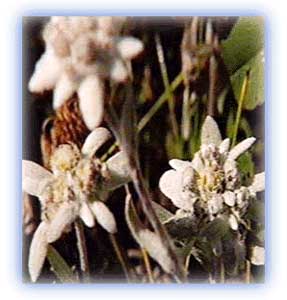Flora and fauna
General Info
· Flora
· Tropical Forests
· Sub-alpine forests
· Alpine scrubs
· Fauna
· Mammals
· Birds
Why are these animals endangered?
How much money do the poachers make?
Protected Areas
· Nepal
· India

![]()
|
Temperate Forests Temperate forests are mainly found in the middle altitudes of the Himalayas. They are found both along the main Himalayas and on the transition zone between itself and the barren cold desert areas. Dry temperate forests are also found in the drier parts of the Himalayas and the barren Transhimalayan region. The forests are usually found in areas experiencing temperate climate. Their altitude varies from 1800m to 3000m depending on local conditions. |
 |
| Himalayan Edelwiess flower Credit: Karamjeet Singh |
Mixed Temperate Coniferous forests, also known as the western mixed coniferous forests, are an attractive forest typical of the moister regions of the western Himalaya, having a mixture of temperate zone conifers like the deodar, blue pine, fir and spruce. There may occur broad-leaved species mixed with the conifers in small proportions particularly in moist shady depressions.
Individual trees attain a height of more than 40 m though the height attained by the trees of this forest type is relatively lesser than those found in the very moist zone of the western Himalaya. This is probably due to the harsh climatic conditions prevailing in the drier parts.
This forest type is found in the main Himalayas and the transition zone between itself and the cold desert regions, generally between an elevation of 1800 and 3000 m. It is well developed in the upper Ganga valley and Kali valley of Uttarakhand, India, and in the Satluj valley of Kinnaur.
As the name suggests, it grows in areas of typical temperate climate. Summers are mild and warm with the average maximum temperature rarely exceeding 32 C. There is a short autumn season after which winter sets in. The first snowfall of the season may occur as early as in mid- November. Snow accounts for a considerable part of the total annual precipitation. In winter the temperature remains below the freezing point for fairly long period.
During the past few decades these have come under an enormous strain due to due to large scale deforestation for fodder, fuelwood and constructional purposes.
In the wetter parts of the same region exist the Temperate moist mixed deciduous forests have broad-leaved species which thrive in the wetter climate. In the drier regions within these forests, conifers, and even patches of grasslands can be found. Individual trees may attain a height of about 20 m. These forests range from 1800m to 3000m in the relatively wetter regions. it usually develops in moist shady depressions and along streams and rivers. The forests are found all along the main HImalayas as well as in the transition zone to the cold desert regions.
All rights reserved